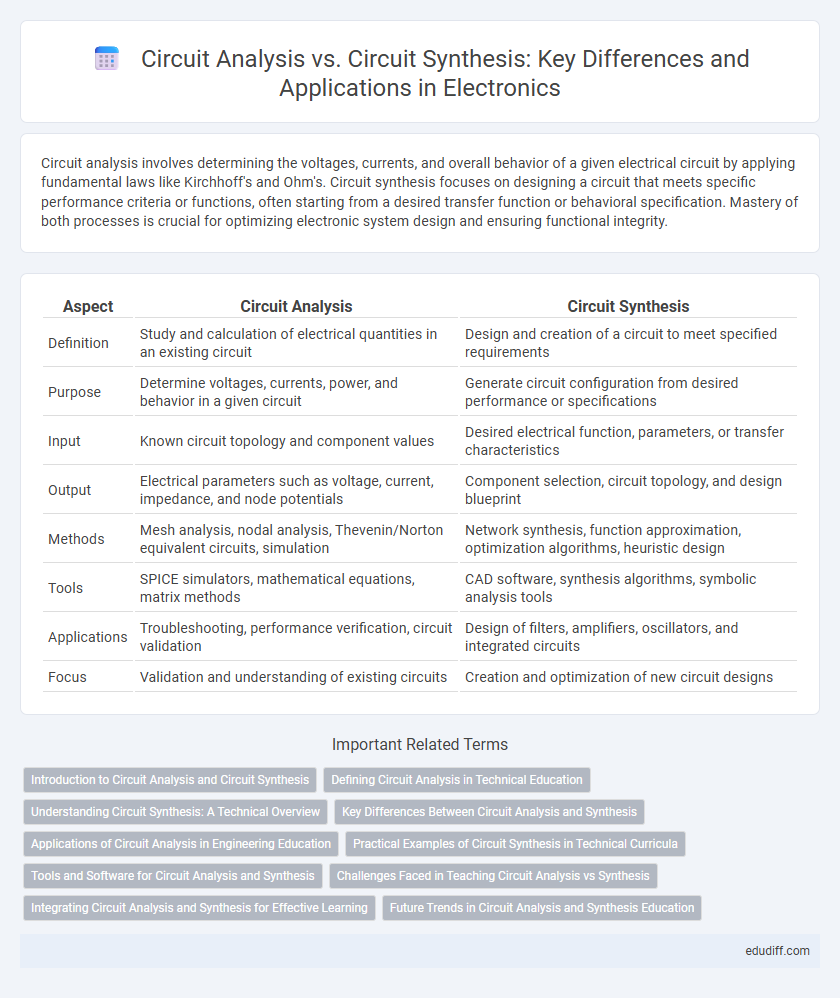Circuit analysis involves determining the voltages, currents, and overall behavior of a given electrical circuit by applying fundamental laws like Kirchhoff's and Ohm's. Circuit synthesis focuses on designing a circuit that meets specific performance criteria or functions, often starting from a desired transfer function or behavioral specification. Mastery of both processes is crucial for optimizing electronic system design and ensuring functional integrity.
Table of Comparison
| Aspect | Circuit Analysis | Circuit Synthesis |
|---|---|---|
| Definition | Study and calculation of electrical quantities in an existing circuit | Design and creation of a circuit to meet specified requirements |
| Purpose | Determine voltages, currents, power, and behavior in a given circuit | Generate circuit configuration from desired performance or specifications |
| Input | Known circuit topology and component values | Desired electrical function, parameters, or transfer characteristics |
| Output | Electrical parameters such as voltage, current, impedance, and node potentials | Component selection, circuit topology, and design blueprint |
| Methods | Mesh analysis, nodal analysis, Thevenin/Norton equivalent circuits, simulation | Network synthesis, function approximation, optimization algorithms, heuristic design |
| Tools | SPICE simulators, mathematical equations, matrix methods | CAD software, synthesis algorithms, symbolic analysis tools |
| Applications | Troubleshooting, performance verification, circuit validation | Design of filters, amplifiers, oscillators, and integrated circuits |
| Focus | Validation and understanding of existing circuits | Creation and optimization of new circuit designs |
Introduction to Circuit Analysis and Circuit Synthesis
Circuit analysis involves evaluating existing electrical circuits to determine current, voltage, and power distribution using methods such as nodal analysis, mesh analysis, and Thevenin's theorem. Circuit synthesis focuses on designing circuits that meet specific functional requirements by selecting and connecting components systematically to achieve desired performance. Understanding fundamental principles in circuit analysis is essential before applying synthesis techniques to create efficient and reliable electronic systems.
Defining Circuit Analysis in Technical Education
Circuit analysis involves systematically examining electrical circuits to determine voltages, currents, and power across components, using methods such as Kirchhoff's laws, Thevenin's theorem, and node-voltage techniques. It forms a fundamental part of technical education by developing problem-solving skills necessary for diagnosing and optimizing circuit performance. Emphasizing circuit analysis equips students with the ability to interpret complex circuit behaviors and prepare for advanced studies in circuit synthesis and design.
Understanding Circuit Synthesis: A Technical Overview
Circuit synthesis involves designing circuits from a given set of specifications and desired functions, focusing on creating efficient, optimized, and functional electrical networks. It employs techniques such as Boolean algebra simplification, logic minimization, and algorithmic methods to construct circuits that meet performance criteria with minimal components. Compared to circuit analysis, which interprets and predicts circuit behavior, synthesis proactively generates circuit topologies tailored to specific operational requirements.
Key Differences Between Circuit Analysis and Synthesis
Circuit analysis involves examining an existing electrical circuit to determine voltages, currents, and power using laws such as Ohm's and Kirchhoff's, emphasizing the behavior of predefined network elements. Circuit synthesis focuses on designing or creating a circuit that meets specific performance criteria by selecting and arranging components to achieve desired impedance, transfer functions, or frequency responses. The key difference lies in analysis being diagnostic and evaluation-oriented, while synthesis is generative, aiming to produce a circuit configuration based on targeted specifications.
Applications of Circuit Analysis in Engineering Education
Circuit analysis plays a critical role in engineering education by providing students with essential skills to understand and predict electrical circuit behavior, ensuring proper design and troubleshooting of electronic systems. It enables practical application of theoretical concepts, such as Ohm's Law and Kirchhoff's Laws, in analyzing complex networks of resistors, capacitors, and inductors. Mastery of circuit analysis techniques prepares future engineers for effective problem-solving in fields like power systems, telecommunications, and embedded system design.
Practical Examples of Circuit Synthesis in Technical Curricula
Circuit synthesis involves designing circuits from specifications using techniques such as Boolean algebra and Karnaugh maps to minimize logic functions. Practical examples in technical curricula include creating combinational circuits like multiplexers and arithmetic logic units, showcasing the transformation of abstract logic into implementable hardware. These hands-on projects reinforce understanding of component selection, circuit optimization, and real-world application constraints in electronic design.
Tools and Software for Circuit Analysis and Synthesis
Circuit analysis tools such as SPICE and Multisim provide detailed simulations that model circuit behavior under various conditions, enabling engineers to verify and optimize designs accurately. Circuit synthesis software like Synopsys Design Compiler and Cadence Genus automate the conversion of high-level descriptions into gate-level implementations, improving design efficiency and reducing errors. Advanced platforms often integrate both analysis and synthesis capabilities, streamlining the workflow from design conception to verification in complex electronic systems.
Challenges Faced in Teaching Circuit Analysis vs Synthesis
Teaching circuit analysis often involves challenges such as helping students grasp complex mathematical models, differential equations, and the physical interpretation of signals and components. Circuit synthesis presents difficulties in guiding students to design functional circuits from specifications while balancing constraints like cost, power, and reliability. Both require effective pedagogical strategies to bridge theoretical knowledge and practical application, with synthesis demanding more emphasis on creative problem-solving and optimization techniques.
Integrating Circuit Analysis and Synthesis for Effective Learning
Integrating circuit analysis and synthesis enhances practical understanding by enabling students to design circuits while simultaneously evaluating their performance through analytical techniques. This dual approach fosters problem-solving skills by connecting theoretical concepts with real-world applications in electrical engineering. Employing this strategy accelerates mastery of complex circuit functions and improves innovation in circuit design processes.
Future Trends in Circuit Analysis and Synthesis Education
Future trends in circuit analysis and synthesis education emphasize integrating AI-driven simulation tools and machine learning algorithms to enhance precision and efficiency in design processes. Educational curricula are increasingly incorporating hands-on experience with advanced CAD software and hardware description languages to prepare students for the complexities of modern electronic systems. Emphasis on interdisciplinary knowledge including embedded systems and IoT applications is shaping the skillset required for next-generation circuit engineers.
Circuit Analysis vs Circuit Synthesis Infographic

 edudiff.com
edudiff.com